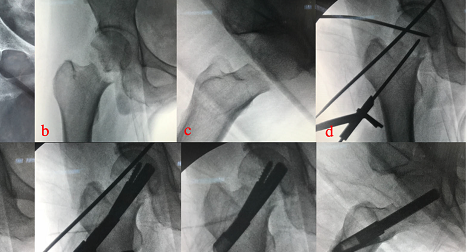Femoral Neck System (FNS): A Biomechanical Strong Solution for Stable Fixation in Basi cervical Neck of Femur Fractures
Abstract
Background: Due to their rarity and probable instability, basicervical femoral neck fractures whose frequency ranges from 1.8 to 7.6% present difficulties and have higher repair failure rates than intertrochanteric fractures. Even though the fracture site is extracapsular, surgical treatment is still difficult. Objectives: This study was done for assessment of femoral neck system (FNS) as a biomechanical strong solution for stable fixation in basicervical neck of femur fractures. Methods: The cross-sectional Observational study was conducted in the Department of Orthopedic, National Institute of Traumatology and Orthopedic Rehabilitation (NITOR) from June 2022 to May 2023. A total of 30 patients of both sexes were included in the study. Data was collected over a period of 12 months and analyzed by appropriate computer based programmed software Statistical Package for the Social Sciences (SPSS), version 24. Results: In this study, most of the respondents 18 (60.7%) lies between 51 years to 60 years. Mean ± SD of the respondents was 52.41 ± 6.75 years. More than half of the patient 19 (63.30%) were male and 11 (36.70%) patients were female. Most of the patients 17 (56.7%) BMI were in between normal range, 7 (23.3%) were underweight and 6 (20.0%) were overweight. Mean ± SD of the patients BMI was 25.3 ± 5.4 kg/m2. About 12 (40.0%) patients had type III garden fracture, 9 (30.0%) patients had type II garden fracture, and 9 (30.0%) patients had type I garden fracture. Most of the patients 21 (70.0%) had type II Pauwels fracture. The average surgery time was 76.65 ± 34.25 min, the blood loss was 67.45 ± 51.43 ml, the Preoperative Harris Score was 22.25 ± 4.56 and the Postoperative Harris Score was 83.80 ± 5.78, the healing time was 3.33 ± 0.60 and Femoral neck shortens was 2.20 ± 1.41mm. Non-union had occurred in case of 3 (10.0%) patients, Femoral neck shortening had occurred in 2 (6.7%) case and Femoral neck necrosis had occurred in 1 (3.3%) case. Conclusion: FNS treatment can produce good clinical outcomes for patients with basi cervical femoral neck fractures. FNS exhibits much greater overall construct stability and superior biomechanical qualities. Key words: Femoral neck system, Femoral neck fracture, Harris Hip Score, Surgical fixation devices
Downloads
References
• Florschutz AV, Langford JR, Haidukewych GJ, Koval KJ. Femoral neck fractures: current management. J Orthop Trauma. 2015;29(3):121–9. https:// doi.org/10.1097/BOT.0000000000000291.
• Slobogean GP, Sprague SA, Scott T, Bhandari M. Complications following young femoral neck fractures. Injury. 2015;46(3):484–91. https://doi.org/10.1016/j.injury.2014.10.010.
• Stockton DJ, Dua K, O’Brien PJ, Pollak AN, Hoshino CM, Slobogean GP. Failure patterns of femoral neck fracture fixation in young patients. Orthopedics. 2019;42(4):e376–80. https://doi.org/10.3928/01477447-20190321-03.
• Panteli M, Rodham P, Giannoudis PV. Biomechanical rationale for implant choices in femoral neck fracture fixation in the non-elderly. Injury. 2015;46(3):445–52. https://doi.org/10.1016/j.injury.2014.12.031.
• Stoffel K, Zderic I, Gras F, Sommer C, Eberli U, Mueller D, et al. Biomechanical evaluation of the femoral neck system in unstable Pauwels III femoral neck fractures: a comparison with the dynamic hip screw and cannulated screws. J Orthop Trauma. 2017;31(3):131–7. https://doi.org/10.1097/BOT.0000000000000739.
• Schopper C, Zderic I, Menze J, Müller D, Rocci M, Knobe M, et al. Higher stability and more predictive fixation with the femoral neck system versus Hansson Pins in femoral neck fractures Pauwels II. J Orthop Transl. 2020;24: 88–95. https://doi.org/10.1016/j.jot.2020.06.002.
• Mercuriali F, Inghilleri G. Proposal of an algorithm to help the choice of the best transfusion strategy. Curr Med Res Opin. 1996;13(8):465–78. https://doi. org/10.1185/03007999609115227.
• Garden RS. Low-angle fixation in fractures of the femoral neck. J Bone Joint Surg Br. 1961;43(4):647–63.
• Gerard P, Slobogean DJS, Zeng B, Wang D, Ma B-T, Pollak AN. Femoral neck fractures in adults treated with internal fixation: a prospective multicenter Chinese cohort. J Am Acad Orthop Surg. 2017;25(4):279–303.
• Zlowodzki M, Ayeni O, Petrisor BA, Bhandari M. Femoral neck shortening after fracture fixation with multiple cancellous screws: incidence and effect on function. J Trauma. 2008;64(1):163–9. https://doi.org/10.1097/01.ta. 0000241143.71274.63.
• Augat P, Bliven E, Hackl S. Biomechanics of femoral neck fractures and implications for fixation. J Orthop Trauma. 2019;33(Suppl. 1):S27–32. https:// doi.org/10.1097/BOT.0000000000001365.
• Shu DP, Xiao YP, Bei MJ, Ji T, Peng YJ, Ma B, et al. Dynamic compression locking system versus multiple cannulated compression screw for the treatment of femoral neck fractures: a comparative study. BMC Musculoskelet Disord. 2020;21(1):230. https://doi.org/10.1186/s12891-020-03259-5.
• Liporace F, Gaines R, Collinge C, Haidukewych GJ. Results of internal fixation of Pauwels type-3 vertical femoral neck fractures. J Bone Joint Surg Am. 2008;90(8):1654–9. https://doi.org/10.2106/JBJS.G.01353.
• Wang CT, Chen JW, Wu K, Chen CS, Chen WC, Pao JL, et al. Suboptimal outcomes after closed reduction and internal fixation of displaced femoral neck fractures in middle-aged patients: is internal fixation adequate in this age group? BMC Musculoskelet Disord. 2018;19(1):190. https://doi.org/10.11 86/s12891-018-2120-9.
• Haider T, Schnabel J, Hochpöchler J, Wozasek GE. Femoral shortening does not impair functional outcome after internal fixation of femoral neck fractures in non-geriatric patients. Arch Orthop Trauma Surg. 2018;138(11):1511–7. https://doi.org/10.1007/s00402-018-3011-0.
• Weil YA, Khoury A, Zuaiter I, Safran O, Liebergall M, Mosheiff R. Femoral neck shortening and varus collapse after navigated fixation of intracapsular femoral neck fractures. J Orthop Trauma. 2012;26(1):19–23. https://doi.org/1 0.1097/BOT.0b013e318214f321.
• Min BW, Lee KJ, Bae KC, Lee SW, Lee SJ, Choi JH. Result of internal fixation for stable femoral neck fractures in elderly patients. Hip Pelvis. 2016;28(1):43–8. https://doi.org/10.5371/hp.2016.28.1.43.
• Sung YB, Jung EY, Kim KI, Kim SY. Risk factors for neck shortening in patients with valgus impacted femoral neck fractures treated with three parallel screws: is bone density an affecting factor? Hip Pelvis. 2017;29(4): 277–85. https://doi.org/10.5371/hp.2017.29.4.277.
• Wu Y, Leu TH, Chuang TY, Ho WP, Chen YP, Lin CY. Screw trajectory affects screw cut-out risk after fixation for nondisplaced femoral neck fracture in elderly patients. J Orthop Surg Hong Kong. 2019;27(2):2309499019840252. https://doi.org/10.1177/2309499019840252.
• Ma JX, Kuang MJ, Xing F, Zhao YL, Chen HT, Zhang LK, et al. Sliding hip screw versus cannulated cancellous screws for fixation of femoral neck fracture in adults: a systematic review. Int J Surg. 2018;52:89–97. https://doi.org/10.1016/j.ijsu.2018.01.050.



























